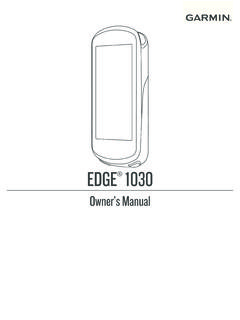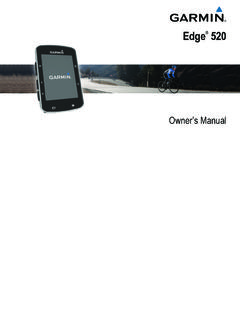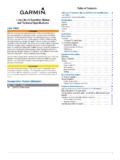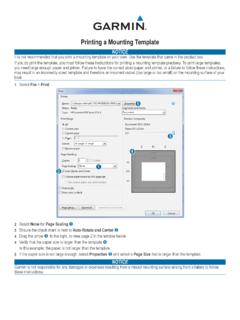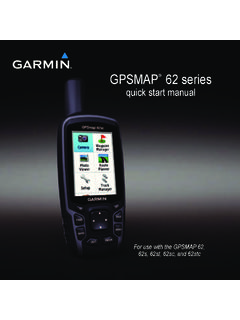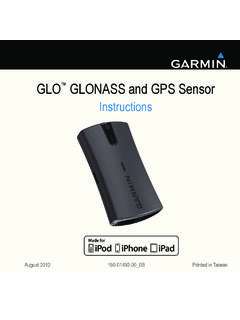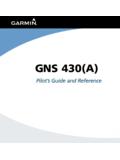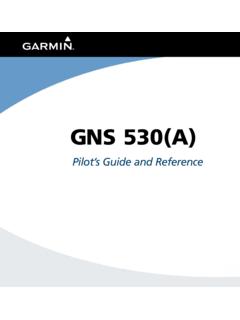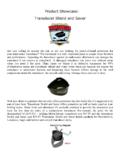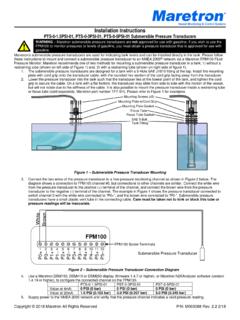Transcription of alcohol. Garmin ClearVü Apply water-based anti …
1 1 Lightly sand the transducer and mounting hardware with a fine-grit abrasive pad. 2 Wipe the transducer and mounting hardware with isopropyl alcohol. Garmin ClearV 3 Apply water-based anti-fouling paint to the transducer and mounting hardware. transducer Transom/ Mounting Consideration To ensure peak performance with the lowest noise and interference, you should route the transducer cable away from Trolling Motor Mount ignition wires, house batteries and wires, trolling motor batteries and wires, and high-energy wires such as radar, audio amplifier, and autopilot pump wires. Installing the transducer on a Transom Mounting Location Considerations The transducer should be mounted parallel to the water line. The transducer should be mounted as close to the center of the boat as possible. Installation Instructions If your propeller moves clockwise when the boat moves, the transducer should be mounted on the starboard side.
2 If your propeller moves counter-clockwise when the boat Important Safety Information moves, the transducer should be mounted on the port side. WARNING The transducer should not be mounted behind strakes, struts, See the Important Safety and Product Information guide in the fittings, water intake or discharge ports, or anything that chartplotter or fishfinder product box for product warnings and creates air bubbles or causes the water to become turbulent. other important information. The transducer must be in clean (non-turbulent) water for You are responsible for the safe and prudent operation of your optimal performance. vessel. Sonar is a tool that enhances your awareness of the The transducer should not be mounted in a location where it water beneath your boat. It does not relieve you of the might be jarred when launching, hauling, or storing.
3 Responsibility of observing the water around your boat as you navigate. On single-drive boats, the transducer must not be mounted in the path of the propeller. CAUTION. The transducer can cause cavitation that can degrade the Failure to install and maintain this equipment in accordance with performance of the boat and damage the propeller. these instructions could result in damage or injury. On boats with outboard or inboard/outboard motors, the Always wear safety goggles, ear protection, and a dust mask transducer should be mounted at least 38 cm (15 in.) from when drilling, cutting, or sanding. the propeller. NOTICE On twin-drive boats, the transducer should be mounted When drilling or cutting, always check what is on the opposite between the drives, if possible. side of the surface. This equipment should be installed by a qualified marine Assembling the transducer with a Transom Mount installer.
4 Bracket 1 Attach the mount to the transducer with the included To obtain the best performance and to avoid damage to your star washers , and screws . boat, you must install the Garmin device according to these . instructions. Read all installation instructions before proceeding with the installation. If you experience difficulty during the installation, contact Garmin Product Support. Tools Needed Drill and drill bits Number 2 Phillips screwdriver Masking tape Marine sealant Preparing the transducer for Long-Term Exposure to Water NOTICE 2 Attach the mount to the bracket with the bolt , rubber Do not use acetone or acetone-based products on the washer , flat washer , and lock nut . transducer . Acetone damages the plastic transducer housing. NOTE: The bolt should be tight enough to hold the When you install a transducer on a boat that spends a transducer in place when the boat moves at high speed, but significant amount of time in the water, you should coat the loose enough to allow the transducer to pivot out of the way if transducer and mounting hardware with a water-based anti- the transducer hits an obstruction.
5 Fouling paint to prevent marine growth. February 2017 Printed in Taiwan 190-02116-02_0A. Installing the Transom-Mount Hardware 14 If you marked a pilot hole in step 7, choose the appropriate NOTICE drill bit to drill a pass-through hole completely through the transom: If you are mounting the bracket on fiberglass with screws, it is recommended to use a countersink bit to drill a clearance If you have the 4-pin cable, use a 16 mm (5/8 in.) drill bit. counterbore through only the top gel-coat layer. This will help to If you have the 8-pin cable, use a 25 mm (1 in.) drill bit. avoid cracking in the gel-coat layer when the screws are 15 Route the transducer cable to the sounder: tightened. If you are routing the cable using a pass-through hole, The cables connected to the transducer should not be cut, push it through the pass-through hole, and install the because cutting the transducer cables voids your warranty.
6 Cable-entry cover (Installing the Cable-Entry Cover, 1 Cut out the template. page 2). 2 With the template aligned vertically on the transom at the If you are not routing the cable using a pass-through hole, installation location (Mounting Consideration, page 1), place route the cable up and over the top of the transom. the bottom corner of the template on the edge of the You should avoid routing the cable close to electrical wires or transom. other sources of electrical interference. Installing the Cable-Entry Cover If you routed the cable through the transom after you installed the transducer , you should install the cable-entry cover to keep water from entering your boat. 1 Place the cable-entry cover over the hole and the cable, with the opening pointing downward, and mark the location of the two pilot holes. 3 Mark the center location of the two holes of the template.
7 4 Remove the template from the transom. 5 Wrap a piece of tape around a 4 mm (5/32 in.) bit at 18 mm (7/10 in.) from the point of the bit, to avoid drilling the pilot holes too deep. 6 If you are installing the bracket on fiberglass, place a piece of 2 Remove the cable-entry cover, and, using a mm (1/8 in.). tape over the pilot-hole location to reduce cracking of the gel bit, drill the pilot holes approximately 10 mm (3/8 in.) deep. coat. 3 Fill the pass-through hole with marine sealant so it covers the 7 Using the 4 mm (5/32 in.) bit, drill the pilot holes approximately cable completely and there is excess sealant around the hole 18 mm (7/10 in.) deep at the marked locations. and the cable. 8 Apply marine sealant to the included 20 mm screws, and 4 Place the cable-entry cover over the hole and the cable, with attach the transducer assembly to the transom.
8 The opening pointing downward. 9 Route the cable under the transom mount cable hook. 5 Apply marine sealant to the included 12 mm M4 screws, and attach the cable-entry cover to the transom. 6 Wipe away all excess marine sealant. Testing the Installation NOTICE. You should check your boat for leaks before you leave it in the water for an extended period of time. Because water is necessary to carry the sonar signal, the transducer must be in the water to work properly. You cannot get a depth or distance reading when out of the water. When you place your boat in the water, check for leaks around any screw holes that were added below the water line. Testing the Transom-Mount transducer Installation NOTICE. 10 If you must route the cable through the transom, choose a When adjusting the depth of the transducer , make the pilot-hole location well above the waterline and mark it.
9 Adjustments in small increments. Placing the transducer too deep can adversely affect the performance of the boat and put 11 Place a cable clamp on the transducer cable, approximately halfway between the transducer and the top of the transom or the transducer at risk of striking underwater objects. the pass-through pilot hole. Test the transom-mount transducer installation in open water 12 Mark the pilot-hole location for the cable clamp, and using a free of obstacles. Pay attention to your surroundings as you test mm (1/8 in.) bit, drill a pilot hole approximately 10 mm the transducer . (3/8 in.) deep. 1 With the boat in the water, turn on the chartplotter. 13 Apply marine sealant to the included 12 mm screw, and attach the cable clamp to the transom. 2. 2 Drive the boat at a slow speed. If the chartplotter appears to 4 Position the transducer so it is parallel to the bottom when in be working properly, gradually increase speed while use.
10 Observing the chartplotter. 5 Use the included cable ties to secure the transducer cable. 3 If the sonar signal is suddenly lost or the bottom return is 6 Route the transducer cable to the installation location of the severely degraded, note the speed at which this occurs. sounder while taking these precautions. 4 Return the boat to the speed at which the signal was lost, The cable should not be routed close to electrical wires or and make moderate turns in both directions while observing other sources of electrical interference. the chartplotter. The cable must not be pinched when the trolling motor is 5 If the signal strength improves while turning, adjust the deployed or stowed. transducer so that it extends another 1/8 in. (3 mm) below the transom of the boat. Software Update 6 Repeat steps 2 4 until the degradation is eliminated. You may need to update the device software when you install 7 If the signal does not improve, move the transducer to a the device or add an accessory to the device.
